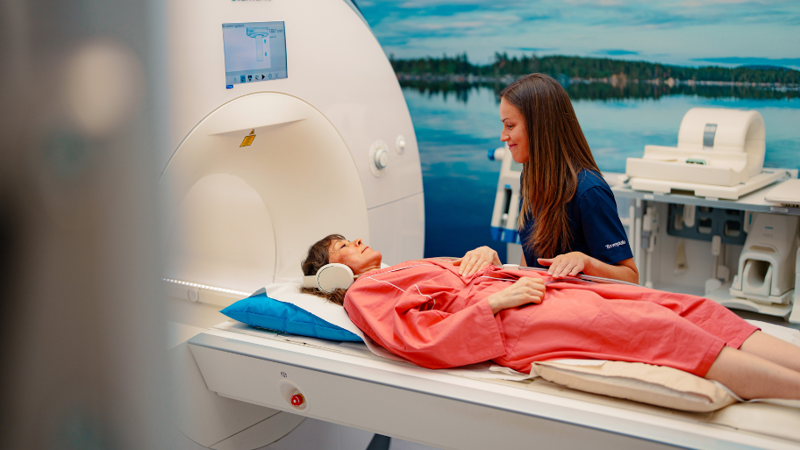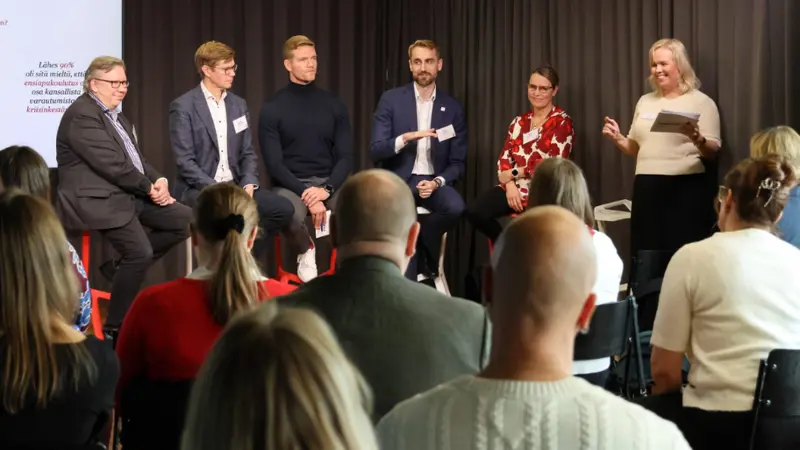No amount of therapy is enough if the work-related causes are not resolved
For work to produce well-being for its creators, the work community must be taken care of. Sari Nuikki, senior occupational health psychologist at Terveystalo, explains what supervisors can do to ensure a healthy working life.

The job of a miner used to be life-threatening. Toxic gases could accumulate in the shafts of coal mines and people could not detect them in time. Then it was discovered that the canary was a good alarm. When the bird stopped singing or fainted, miners knew that the working environment had become harmful. Thanks to the canary, they were able to get out of the mines in time.
Today's canaries are workers who are sick, ill and exhausted from work. They are alarm bells for working conditions that have become dangerous to health. So compares Sari Nuikki, senior occupational health psychologist at Terveystalo.
– An exhausted worker is a signal that the work community is not doing well. Something in the work community, at work or in management needs to be corrected.
Mental health problems and work-related fatigue among working-age people have increased rapidly in recent years. They have become a major risk to work performance and a cause of sick leave.
Each employee who is ill because of their job is treated individually, but many – especially young people – end up voting with their feet if they are not doing well in their workplace. They are replaced by new recruits who may still fall ill at work or move on to other jobs.
– The goal of the workplace should be to help people feel better, says Nuikki.
Adjusting viewpoint from individuals to work communities
According to Nuikki, organisations' supervisors, managers and HR often turn to occupational health too late. Many hope that time will heal or that the problem will go away on its own.
– This is an illusion; the situation tends to get worse as it drags on.
Nuikki believes that the focus of care should shift from the individual to the workplace.
– No amount of therapy is enough if the root causes at work are not addressed, corrected and prevented, she adds.
Statutory occupational health care includes a workplace survey to determine the conditions in the workplace. What are the psychosocial stress factors at work? And what are the strengths and resources of the work community?
Workplace surveys are relatively rare, but many organisations often carry out pulse and well-being surveys. It is also a good idea to discuss the results of these regularly with the occupational health team.
– It often turns out that supervisors need support in their management work. This need should be met, as they play a very crucial and pressurised role, says Nuikki.
When everyone is allowed to work to their own strengths, the work itself is motivating. Strengths-based management builds a healthy working life. Nuikki encourages organisations to support the work of supervisors by offering them training, guidance and coaching as an employment benefit. In particular, Nuikki recommends group coaching for managers.
– They help supervisors learn good management practices and get peer support from each other. They can rely on each other even after the actual coaching.
Together with the occupational psychologist, the supervisor can also plan workshops for the work community.
– It's no good just saying that we're doing OK. Instead, it's good to think about how to make the work community thrive.
If a supervisor doesn't address small problems in the workplace, they can grow into big ones. You shouldn't wait for an employee to get sick at work and only then start lightening their workload. “
Sari Nuikki, senior occupational health psychologist at Terveystalo
Small steps can go a long way
But how can a supervisor make a difference to the well-being of the work community in the face of intense pressure on results?
Nuikki answers that there are many small things you can do on a day-to-day level to improve wellbeing, together with the work community. For example, the work community can go through success stories on a weekly basis and agree on common rules for meetings and prioritising work tasks.
– It is proactive to build a workplace culture that regularly discusses job satisfaction and workload. The role of the manager is to ask how employees are doing.
Nuikki calls for attention to the resources of the work community. What are all the good things in the workplace? How are these strengths maintained? And how can they be used to manage stress factors?
– Often strengths and resources are also ways of solving problems, says Nuikki.
She suggests a change of direction in working life: instead of making development plans to address employees' weaknesses, focus on their strengths and assign tasks to the work community on the basis of those strengths.
– When everyone is allowed to work to their strengths, work itself is motivating. Strengths management builds a healthy working life.
Towards a healthier working life
In a healthy working life, employees feel that they are developing in their work, have the support of their supervisors and can recover during their working hours. Work is smooth, with clear objectives and a workload that is kept to a suitable amount. The work community takes into account human variability – everyone is not able to perform 100% every day.
– If there is something psychologically stressful going on in an employee's life, such as a divorce or a loved one falling ill, it's a good idea to take a proactive approach to work to avoid work-related, medical problems, says Nuikki.
She points out that research shows that the best way to cope with changes in working life is through collaborative working communities. For example, shared humour reduces stress, increases happiness and creates a common glue between employees.
– All of these things need to be taken care of – even when times are tough, changes are taking place and change negotiations are taking place. In the workplace of the future, it will be increasingly important for the workplace to be a "we" workplace. Community provides workers with resilience, i.e. psychological resilience and flexibility.
Flexibility and empathy are increasingly needed in fast-paced workplaces. In addition, the experience of community makes employees more committed to their workplace.
– Experiences of loneliness and exclusion in the workplace are even more damaging to health than workplace bullying.
In a healthy workplace, everyone can be themselves. But that doesn't mean that everyone gets to put frogs in their mouths.
– First responders must address inappropriate comments immediately and in front of everyone. This creates a psychologically safe working culture, Nuikki continues.
Nothing will change or be fixed in a workplace if problems are not raised and addressed. When a workplace feels safe, employees have the courage to speak up about their problems – in time.
It all starts with humanity. According to Nuikki, humanity in management is about taking into account everyone's basic psychological needs: we need autonomy, a sense of control and capability, and the experience of being liked and being part of a community.
– All of these need to be taken care of – even when times are tough, when there are changes and possible lay offs, emphasises Nuikki. From ivory tower to management, humanity brings well-being to employees. Every supervisor is incomplete, doesn't know everything and cannot do everything.
There is one question a manager should ask himself from time to time: does the work bring well-being to his employees?
– If the answer is no, it is worth taking action. But don't do it on your own – ask your occupational health partner for support. It is a good idea to spar with an occupational health psychologist about what works.
Nuikki's main advice to supervisors is that the earlier and more proactive the reaction, the better.
– When you think about whether you should do something, you usually should.
Nuikki returns to her parable of the canaries in the coal mines. She says that it's a good idea for the supervisor and the work community to think together about what everyone can do to improve everyone's wellbeing.
– If we succeed in increasing the well-being of the work community, the productivity of each employee will increase.
Solutions for creating healthy workplaces – from individuals to the organizational level
A healthy workplace is not created by chance, but through planning. Increased workload from professional and personal life manifests as sick leaves. Although treating the symptoms may resolve acute issues, a healthier work environment is built on a more sustainable foundation by focusing on the sources of the workload. To achieve the most effective results, we must proactively solve these root causes that threaten the workplace. As a partner in the workplace, we help prioritize what is most important.
Lue lisää aiheesta

Terveystalo's digital services have been awarded the internationally recognized ISO27001 information security certification.
Terveystalo's information security practices, processes, and risk management are in line with international best practices.

Does massage help relieve stress? – Touch restores and calms the body and mind
Stress is not always visible on the outside, but the body does show signs when the strain increases. According to Lassi Ylönen, a trained massage therapist at Terveystalo Rela, the body often communicates stress through subtle signs.

Circular economy and artificial intelligence boost performance and improve care
At the heart of sustainable healthcare, technology serves as a tool for improving both the quality of care and accountability. Terveystalo favors solutions that combine sustainability, cost-effectiveness, and medical expertise.

Psychologist: How to make Christmas a relaxed and personal celebration
For many, the anticipation of Christmas begins when cities are decked out in seasonal lights and the first chocolates, calendars, and gingerbread cookies appear on store shelves. Christmas carols ring out and the Tonttuparaati choir sings “Kiire jo on! Kiire jo on!” (Hurry up! Hurry up!). This warm and atmospheric celebration also brings other feelings to mind: how on earth can we get through all this without losing our joy and peace in the rush?

Terveystalo and Gosta Labs deepen their cooperation: the goal is to streamline work with a superior patient information system
Terveystalo is deepening its cooperation with Finnish health technology company Gosta Labs and investing €1 million in the company as a minority investor. The aim is to jointly develop artificial intelligence solutions that improve the quality of care and the efficiency of reception work as part of Terveystalo's new patient information system, Terveystalo Ella.

First aid preparedness in companies requires action and courage
First aid skills increase resilience, but a barometer survey of Finnish organizations' first aid capabilities published in October reveals that the number of trained personnel is alarmingly low.